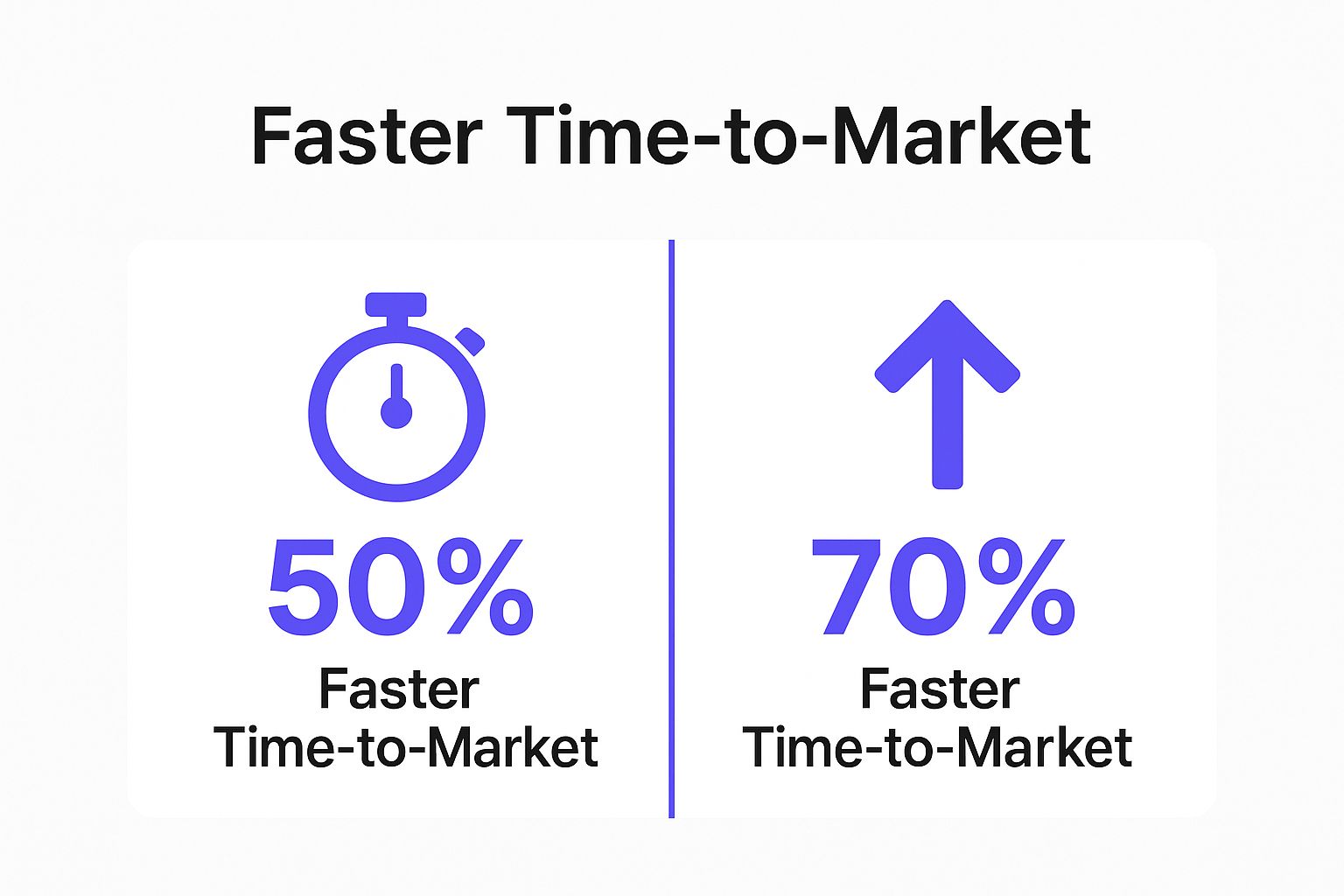
In a competitive market, understanding your customers is the bedrock of sustainable growth. Yet, vital customer data is often fragmented, scattered across dozens of applications like CRMs, support desks, usage logs, and billing systems. This siloed information creates a disjointed and incomplete picture, making it nearly impossible for teams to act proactively. Data integration solves this fundamental problem by consolidating disparate data sources into a single, unified view, transforming chaotic information into clear, actionable intelligence.
The core benefits of data integration extend far beyond tidy dashboards; they empower teams to shift from reactive problem-solving to strategic relationship management. For customer success, this means anticipating churn, identifying upsell opportunities, and delivering personalized experiences at scale. This article explores the seven most impactful benefits, demonstrating how a cohesive data strategy can revolutionize your approach to customer retention and drive significant business growth. We'll examine how creating a 360-degree customer view, enhancing decision-making, and automating processes directly translates to a stronger bottom line. You will learn practical ways to implement these strategies and see how unified data provides the foundation for more intelligent, efficient, and customer-centric operations.
One of the most powerful benefits of data integration is its ability to create a 360-degree customer view. This concept involves consolidating data from every customer touchpoint into a single, comprehensive profile. Instead of viewing customer interactions in isolated silos like CRM entries, support tickets, or social media comments, a 360-degree view unifies them. This provides a holistic understanding of each customer's behavior, preferences, and overall journey with your brand.

When customer success managers (CSMs) have this unified data, they can move from reactive problem-solving to proactive engagement. Imagine a CSM seeing that a high-value customer has recently submitted a support ticket, stopped using a key feature, and visited the pricing page. This consolidated view signals a potential churn risk that would be invisible if the data remained fragmented across different systems.
Giants like Salesforce, with its Customer 360 platform, have popularized this approach. They demonstrate how integrating sales, service, and marketing data allows teams to collaborate effectively. For example, a marketing team can see a customer's recent service issues and avoid sending them an upsell promotion, opting for a helpful content piece instead. Similarly, Starbucks uses its mobile app to integrate purchase history, location data, and loyalty status to offer personalized promotions that drive repeat business.
Achieving a true 360-degree view is a strategic process. Here are actionable steps to get started:
Another of the core benefits of data integration is the power it gives to strategic decision-making. By consolidating information from disparate sources into a single, coherent dataset, organizations can perform more accurate and comprehensive analytics. This unified approach breaks down data silos, providing leaders with complete, consistent information to base their choices on. This directly reduces the risk of making critical decisions based on incomplete or conflicting data.

When data is fragmented, a marketing team might see a campaign's success based on lead generation, while the sales team sees low conversion rates from those same leads. Data integration brings these perspectives together, revealing the full picture. Decision-makers can then accurately assess ROI, allocate resources effectively, and pivot strategies with confidence. This holistic view is crucial for everything from product development to operational efficiency.
Retail and logistics giants have perfected this approach. Walmart optimizes its massive supply chain by integrating real-time sales data from stores, inventory levels in warehouses, and supplier performance metrics. This allows it to forecast demand with incredible accuracy and prevent stockouts. Similarly, UPS uses its ORION (On-Road Integrated Optimization and Navigation) system, which integrates GPS, traffic, and delivery data to optimize routes for its drivers, saving millions in fuel costs and time.
Creating a unified analytics framework requires a structured approach. Here are actionable steps to implement it:
Beyond customer-facing insights, another of the core benefits of data integration is its ability to radically improve operational efficiency. It achieves this by automating data flows between previously disconnected systems, which eliminates the need for manual data entry and removes redundant, error-prone processes. This frees employees from time-consuming data management tasks, allowing them to focus on strategic, high-value activities that drive business growth.

This automation directly impacts productivity and accuracy. For instance, when a new customer signs a contract in a sales CRM, data integration can automatically create their account in the billing system, provision their access in the product platform, and generate a welcome ticket in the support desk. This seamless workflow prevents data silos, reduces the chance of human error, and ensures a smooth, immediate onboarding experience for the customer without manual intervention.
Workflow automation platforms like Zapier exemplify this principle by connecting over 5,000 different applications, allowing businesses to create automated "Zaps" without writing code. A customer success team could use it to automatically create a task in their project management tool whenever a high-priority support ticket is logged. Similarly, enterprise systems like SAP integrate finance, supply chain, and HR functions, automating processes like procure-to-pay and order-to-cash to ensure operational consistency and efficiency across the entire organization.
Strategically automating workflows requires careful planning and execution. Here are actionable steps to get started:
Another of the core benefits of data integration is its direct impact on enhancing data quality and consistency. Without integration, data exists in isolated systems, each with its own formatting rules, definitions, and potential for errors. Data integration acts as a powerful cleansing and standardization engine, establishing a single source of truth for all business information.
This process involves creating standardized formats, applying validation rules, and implementing cleansing processes as data moves from disparate sources into a central repository. By consolidating information through a unified system, organizations can programmatically identify and rectify inconsistencies, eliminate duplicate records, and correct errors. This ensures that every team, from customer success to finance, operates with accurate, reliable, and up-to-date information, which is fundamental for sound decision-making.
Enterprise-level data management platforms are prime examples of this benefit. Talend's data integration solutions are used by e-commerce companies to ensure product information is consistent across their website, mobile app, and internal inventory systems, preventing customer frustration and lost sales. Similarly, major financial institutions rely on tools like IBM's InfoSphere to manage customer data quality across global operations, ensuring compliance and accurate risk assessment. Experian also provides data quality solutions that help major retailers cleanse and enrich their customer databases, improving marketing campaign targeting and personalization.
Building a foundation of high-quality data requires a methodical approach. Here are actionable steps to guide your integration strategy:
Beyond improving customer insights, a key benefit of data integration is its direct impact on the bottom line through significant cost reduction and resource optimization. Disconnected systems create immense operational friction, forcing teams to perform manual data entry, manage redundant software licenses, and maintain complex, brittle point-to-point connections. Data integration replaces this chaos with streamlined, automated workflows that dramatically lower operational overhead.
When data flows seamlessly between applications, the need for manual data reconciliation disappears, freeing up valuable employee time for higher-impact activities. This automation reduces human error, which itself carries a high cost in terms of rework and poor decision-making. By consolidating data management, organizations can also decommission redundant legacy systems, cutting down on expensive licensing, maintenance, and IT infrastructure costs.
Many industry leaders have demonstrated the immense financial advantages of integrated data. For instance, Procter & Gamble integrated its global supply chain data, leading to a reported 20% reduction in IT costs and improved inventory management. Similarly, Delta Airlines has saved hundreds of millions of dollars by integrating its operations systems, from flight scheduling to maintenance, allowing for optimized fuel usage and crew assignments. These examples underscore how connecting disparate data sources delivers tangible, measurable financial returns.
Strategically implementing data integration to maximize cost savings requires a clear plan. Here are actionable steps to guide your efforts:
One of the most transformative benefits of data integration is its role as a catalyst for speed. It empowers development teams and business units with immediate access to comprehensive, clean datasets, slashing the time traditionally spent gathering and preparing data for new projects. This acceleration enables organizations to respond faster to market opportunities, test new concepts quickly, and iterate on solutions based on real-time insights rather than stale information.
This infographic highlights how effective data strategies can dramatically shorten development cycles.

The data shows that integrated data can lead to a 50-70% reduction in time-to-market, giving businesses a significant competitive edge. Instead of waiting weeks or months for data, teams can access it on demand, moving from idea to launch in a fraction of the time.
Tech giants exemplify this principle. Netflix's content recommendation engine evolves rapidly because it integrates viewing history, user ratings, and even time-of-day data to refine its algorithms continuously. Similarly, Spotify can quickly develop and launch features like "Discover Weekly" by leveraging its deeply integrated ecosystem of user listening habits, playlist data, and music metadata. These companies don't just use data; they use integrated data to out-innovate competitors.
Achieving this level of agility is a deliberate process built on a solid data foundation. Here are actionable steps to get started:
Another one of the critical benefits of data integration is the ability to strengthen compliance and risk management frameworks. By consolidating data from disparate systems, organizations gain comprehensive visibility into their entire data landscape. This unified view makes it significantly easier to monitor, enforce, and audit compliance with complex regulations like GDPR, HIPAA, and SOX. Centralized data allows for consistent application of security policies, robust audit trails, and clear data lineage tracking, which are essential for proving compliance and mitigating risk.
In a fragmented data environment, ensuring every system adheres to specific data retention or access control rules is a monumental task. Data integration simplifies this by creating a single point of control. When regulators ask for proof of compliance or an internal audit is conducted, integrated systems can provide a complete and accurate picture of how sensitive data is being collected, stored, used, and deleted, reducing both risk and the administrative burden of compliance.
Financial institutions are leaders in leveraging integration for compliance. JPMorgan Chase utilizes an integrated risk management platform to navigate the complex web of financial regulations, ensuring data consistency across trading, reporting, and customer-facing systems. In the healthcare sector, companies like Johnson & Johnson rely on integrated clinical trial data management to meet strict FDA compliance requirements. Similarly, many European enterprises use platforms like OneTrust to integrate data sources and automate GDPR compliance tasks, from managing consent to handling data subject access requests.
Implementing data integration for compliance requires a strategic approach. Here are actionable steps to get started:
Throughout this article, we've explored the transformative power unlocked by a cohesive data integration strategy. The advantages are not just theoretical; they are tangible, measurable, and critical for modern business success. From achieving a true 360-degree customer view to bolstering operational efficiency and ensuring rigorous compliance, the core theme is clear: breaking down data silos is no longer an option, but a foundational necessity.
The key takeaway is that the benefits of data integration extend far beyond the IT department. They ripple across the entire organization, directly impacting customer success, strategic decision-making, and your bottom line. When your Customer Success Managers (CSMs) can see every interaction, support ticket, and product usage metric in one place, they transition from reactive problem-solvers to proactive, strategic partners for your clients. This unified perspective is the bedrock of world-class customer service and retention.
However, possessing integrated data is only half the battle. The ultimate goal is to translate that information into intelligent, timely action. This is where many organizations encounter a new bottleneck: manual data analysis. Your team can spend more time trying to interpret the data than acting on the insights it contains. To truly capitalize on your investment, you must focus on building a robust framework for execution.
This involves not just connecting systems but also standardizing the processes that leverage the newly available information. To maximize the impact of your unified data strategy and ensure that integrated data leads to truly intelligent action, it's crucial to follow essential API integration best practices. This ensures your data pipelines are secure, scalable, and reliable, forming a trustworthy foundation for the analytics and automation you build on top.
The true evolution in leveraging integrated data comes from applying advanced technologies like Generative AI and machine learning. Imagine a system that doesn't just show you a customer's health score but automatically drafts a personalized check-in email based on their recent product usage, highlighting features they haven't discovered yet. This is the power of turning integrated data into predictive, actionable intelligence.
By automating the "so what" of your data, you empower your CSMs to focus on what they do best: building relationships and delivering strategic value. The future of customer success lies in this synergy between a perfectly unified data landscape and AI-driven platforms that can sift through the noise, identify opportunities, and recommend the next best action. Embracing this model is how you convert the potential energy of your data into the kinetic energy of growth, retention, and unparalleled customer loyalty.
Ready to transform your integrated data into proactive, intelligent action? Statisfy uses Generative AI to analyze your unified customer data, automatically generating the specific insights and recommendations your CSMs need to drive renewals and expansion. See how you can empower your team by visiting Statisfy today.